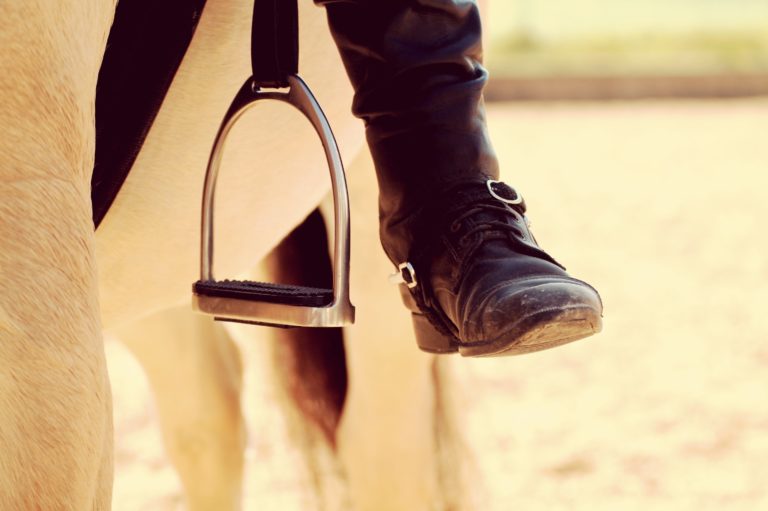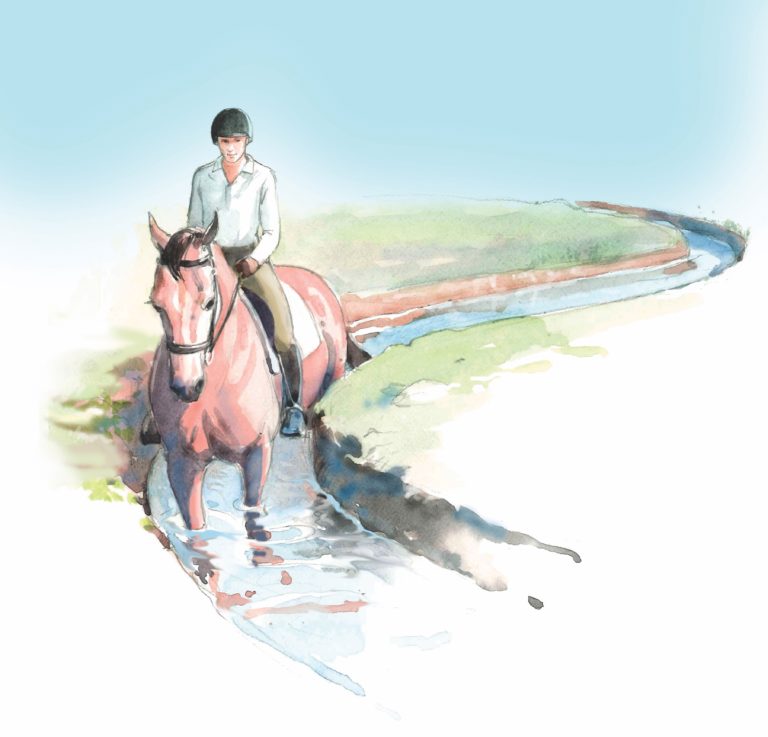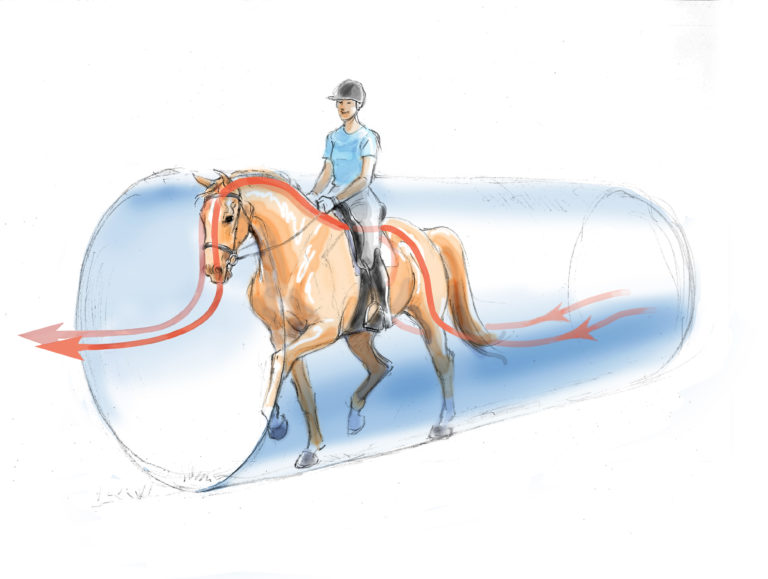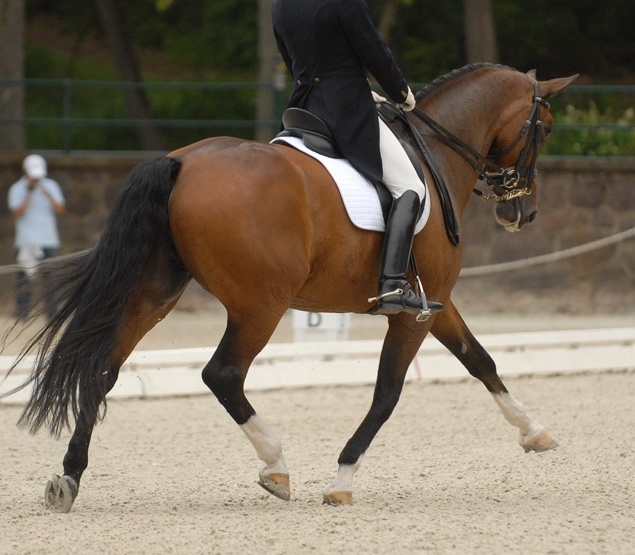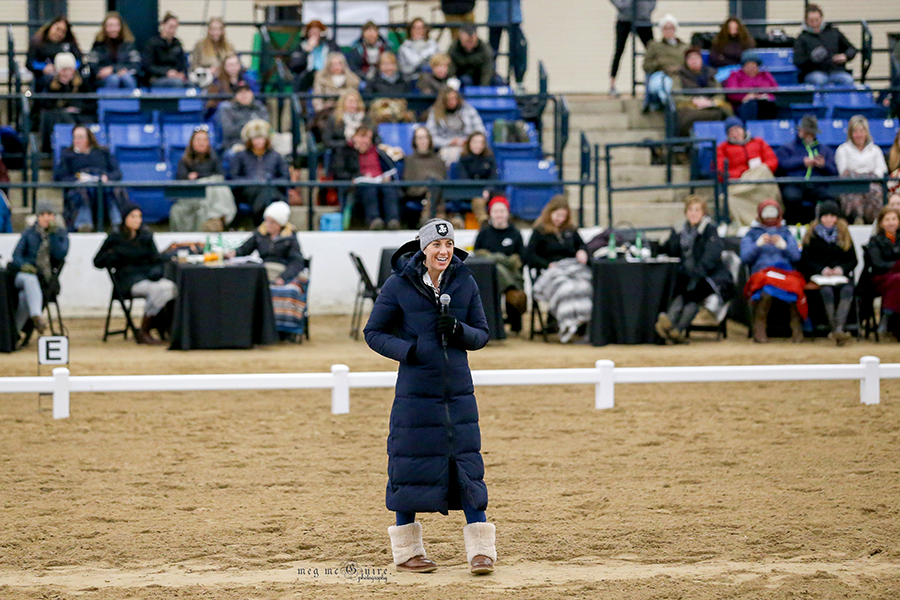
Mere days before the Charlotte Dujardin Masterclass began, Kentucky residents were in the middle of single-digit temperatures—slogging through snow, breaking ice buckets, wrestling with water tank heaters and resembling abominable snowmen. By the time the weekend arrived, Mother Nature had mercy on us and temperatures hovered around the 40s. It felt tropical to many of us, but the indoor arena was still quite chilly and had most auditors bundled up in coolers and blankets to watch Charlotte Dujardin teach. A little cold wasn’t going to stop any of us from soaking up this opportunity.
I’m just your average Adult Amateur rider from the Midwest, with your average horse. Neither one of us is going to see international competition. But what I loved about Dujardin from the beginning, was that she made it clear that with discipline and repetition, you can take average and make it great. As I prepare for my first full season at Prix St. Georges, with my horse whom I have trained from an unbroken 2-year-old, I was ready to be inspired, to be pushed, to be motivated to be a better rider for my horse.
Team EnGaged clinics presented Back to Basics: A Masterclass with Charlotte Dujardin CBE on Jan. 20-11 at the Kentucky Horse Park. More than 500 people arrived to watch a variety of horses and riders train under Dujardin.
The first pair to brave the cold morning and charged atmosphere on Saturday was Ashley Madison and 4-year-old Erdstern who hauled in from Oxford, Pennsylvania. While the duo was warming up, Dujardin spoke briefly about what she looks for in a young horse.
“Save your money buying the horse, and spend it on the training,” she said about purchasing young horses. She stressed that a good walk is important, but she doesn’t look for a “10” walk. Horses with a huge walk are often more difficult to collect, she said. She also looks for a good canter, one with an active hind leg and good engine. And Dujardin said she never worries about the trot, because it can be developed. In fact, a horse with a massive trot actually has a higher risk for injury.
Erdstern clearly had confidence in his rider, and handled the atmosphere with poise beyond his years. Dujardin encouraged the pair to really power forward. “They have their whole life to collect,” she said as she had the pair boldly canter on a circle.
Erdstern and Madison set the bar for the rest of the day. Themes during their session carried on even through the upper level horses. Dressage is about repetition, transitions, straightness and forward. “If he makes a mistake, just keep going,” Dujardin said as the punchy young horse starting offering beautiful, but unauthorized, flying changes.
The next pair in the ring were the snazzy 5-year-old KWPN-NA harness horse, Forevermore, and Jenna Strauss. These two came from Wisconsin to represent a horse currently schooling First and Second Levels. Definitely a much hotter horse than the previous, it took tactful riding and Dujardin’s wisdom to help this gelding relax and work over his back.
Dujardin made several points that in training, don’t just work on what is easy. You learn by making mistakes and doing the things you don’t want to do. These two worked on leg yields and keeping the horse between two reins and two legs. By the end, Forevermore was stretching nicely. It was clear the pair had made progress.
Louisville, Kentucky, resident Susan Harris and her 8-year-old Dutch Warmblood gelding, Endevour Adventure, had a short drive to the Kentucky Horse Park for their rides. Dujardin immediately started pushing this talented pair out of their comfort zone. Many of us get so comfortable riding “safe and pretty,” that we miss out on a horse’s true potential.
Harris and Endevour schooled flying changes, travers, half pass and transitions forward and back. These exercises brought out impressive expression from the spicy gelding and Dujardin commented that he was “the sort of horse [she] look[s] for.”
Elma Garcia and her 16-year-old Hanovarian mare, Wensea, made the trip from North Carolina to ride under Dujardin. A confirmed Prix St. Georges pair, they were lovely to watch and made Dujardin’s exercises look effortless.
Dujardin worked with the pair on controlling the shoulders, half pass and transitions on a circle. One particular exercise seemed key to teaching canter pirouettes. Half pass from the rail to X, then shoulder fore for a few strides. Then a half 10-meter circle in haunches in, and right back to half pass. You could really see Garcia work to control each step of her mare’s shoulders, a vital component to pirouettes.
Finally, the audience was treated to Mel Montagano and her Grand Prix stallion Police. The handsome PRE stallion is a new ride for Montagano, but you wouldn’t know it. Straight away this pair was tackling the building blocks for the Grand Prix zig zag. Dujardin had them start off in leg yield, moving six strides back and forth. Dujardin counting “1, 2, 3, 4, straight, change,” seemed to help Montagano find her rhythm. They also touched on piaffe and passage, where the stallion has clear talent. Dujardin encouraged riders to make the piaffe forward. Don’t start out training in on the spot right away.
Dujardin had a lovely, cheeky way of teaching that kept the atmosphere light and fun, but she also demands quality from her students and at times had some humorous quotes:
•“Lazy horses can be police horses.”
•“Sit on your bum.”
•“Learn to love your right rein like you love the left one.”
•“Pat the horse, slap the rider.”
•“I’m not afraid to make mistakes because I’m going to learn from it.”
•“I could hang my washings on your reins they are so long.”
•“Your legs! Where are they? Are they on holiday?”
•“Do you get time faults going around your dressage test?”
•“If he’s lazy, go for a yeehaw!”
Dujardin also had numerous themes that applied to all horses and riders.
•Go forward. No, really go forward.
● If you make a mistake, keep going.
● Every transition should be a good one.
● Eat, sleep and dream about doing good transitions
● Short reins, hands forward
● Transitions are the foundation.
● It’s about discipline.
● Add power, not speed
● Try not to over-prepare for the flying changes
● Think shoulder-fore when you turn down centerline
● Don’t just work on what’s easy
● Dressage is about repetition
● Understand what your horse is capable of doing
● The horse’s head must be in front of the chest for straightness
● Choose a couple of things to work on each day. Do not drill and exhaust the horse.
As an audience member, I know I was deeply appreciative of the riders who demonstrated their training progress in front of all of us. That takes guts, and personally I admired all of them. The horses were lovely, and it was neat to watch such a variety of types, temperaments and movement.
Finally, many thanks to the sponsors who helped make this fantastic day of learning possible. And for the hot chocolate. It has never tasted so good.
Karen Taylor is an Adult Amateur from Louisville, Kentuckyy. She has trained her horse, Hampton, from a 2-year-old to Prix St. Georges level. When not on a horse, she works for Gannett Newspapers as a visual journalist and designer.


